|
SHEEP SAGA - THE NORTH
RONALDSAYS
Gordon McLachlan
This unique breed now based
principally on the most northerly of the Northern Isles of Orkney - North
Ronaldsay (Map)
- were common on the islands of Orkney and Shetland up to a century and a half
ago. Their origins are uncertain, perhaps indigenous, perhaps introduced with
the Norse colonies of more recent date. Certainly the appearance is not
dissimilar to the Gottland breed although it has been suggested they are
closely related to the prehistoric Palustris. Another similarity is with rare
breeds of Asian arkhan sheep in Kazakhstan.
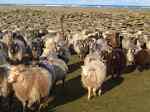 It is a small
short-tailed sheep about 18 inches tall at the shoulder, with intelligent
rather dished faces and with a great variety of fleece colour. They may be
horned or not. Roughly 4% rams and 79% ewes have no horns or small scurs only.
The adult ram generally has a handsome set of curving horns, those of the few
horned ewes are short, or stunted, and generally straight or slightly curved. It is a small
short-tailed sheep about 18 inches tall at the shoulder, with intelligent
rather dished faces and with a great variety of fleece colour. They may be
horned or not. Roughly 4% rams and 79% ewes have no horns or small scurs only.
The adult ram generally has a handsome set of curving horns, those of the few
horned ewes are short, or stunted, and generally straight or slightly curved.
The colour originally showed
great variety - white, grey, black, blue grey, "moorit" light reddish brown or
tanay. However more recently with white wool In demand the coloured sheep tend
to have been eaten more than the white, that is to say while there was still a
reasonably, and relatively, large human population.
Their blood group
interestingly is Group B, that is to say prolific, allowing for deaths in
years of adverse environmental conditions, unlike the hill breeds, say
Scottish Blackface, who are Group A if pure, generally having single lambs and
greater resistance to an adverse environment.
 The notoriety this
breed has received centres on their seaweed eating. The semi-feral flock is
maintained outside a wall running round the edge of the island confining the
sheep to beach and foreshore with two areas of rough pasture described by
Pringle in 1874 as "strips of wasteland", and little changed today. The flock
has available about 193 hectares (477 acres) of rough pasture and about 265
hectares (655 acres) of intertidal ground at low water as its total source of
nourishment outside the wall. The sheep in this area form groups or "clowgangs"
inhabiting a section of the 13 mile shoreline which is divided geologically by
geos, rocky promontories or the conjunction of wall with cliff areas. The
groups are loyal to their section of beach and the small band will "doose" or
butt-off other sheep encroaching on their territory. Low water allows more
freedom of movement so theoretically a sheep could walk around the island in
the intertidal area except that in cliff sections this area is vertical. The notoriety this
breed has received centres on their seaweed eating. The semi-feral flock is
maintained outside a wall running round the edge of the island confining the
sheep to beach and foreshore with two areas of rough pasture described by
Pringle in 1874 as "strips of wasteland", and little changed today. The flock
has available about 193 hectares (477 acres) of rough pasture and about 265
hectares (655 acres) of intertidal ground at low water as its total source of
nourishment outside the wall. The sheep in this area form groups or "clowgangs"
inhabiting a section of the 13 mile shoreline which is divided geologically by
geos, rocky promontories or the conjunction of wall with cliff areas. The
groups are loyal to their section of beach and the small band will "doose" or
butt-off other sheep encroaching on their territory. Low water allows more
freedom of movement so theoretically a sheep could walk around the island in
the intertidal area except that in cliff sections this area is vertical.
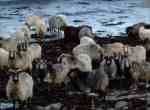 The sheep dyke
itself is of comparatively recent origin being constructed by the surplus
labour available in 1832 after the collapse of the kelp industry at the same
time that land-squaring had taken place instead of the wasteful ancient
run-rig system. Thus the sheep instead of having a diet principally of
terrestrial herbage with a substantial supplement of seaweeds, as had any
sheep, cattle or even deer who have access to shoreline be it island or
sea-loch, now had to exist almost entirely on seaweeds. The exception to this
generality was that pregnant ewes were brought inside the wall prior to
lambing and for a period thereafter to maintain milk yield. The sheep dyke
itself is of comparatively recent origin being constructed by the surplus
labour available in 1832 after the collapse of the kelp industry at the same
time that land-squaring had taken place instead of the wasteful ancient
run-rig system. Thus the sheep instead of having a diet principally of
terrestrial herbage with a substantial supplement of seaweeds, as had any
sheep, cattle or even deer who have access to shoreline be it island or
sea-loch, now had to exist almost entirely on seaweeds. The exception to this
generality was that pregnant ewes were brought inside the wall prior to
lambing and for a period thereafter to maintain milk yield.
Generally there was, and is,
plenty of seaweed available especially in the winter months when gales pile
tangles on the shore by the ton, particularly south easterly gales tearing the
Laminaria hyperborea (cloustoni) from its moorings in the depths of the sound
between Sanday and North Ronaldsay which is 92% covered with deep water
tangles (L. hyperboea 84%, L. saccharina around 16%). Strangely it is the
winter when the North Ronaldsay sheep eat best, the carcases are at their
prime in December. Other times of the year when the deep water tangles are
less plentiful the sheep will wait for low water when the other seaweeds are
exposed; Laminaria digitala grows in the shallows and can be grazed when the
tide is out with some sheep even swimming to rocky outcrops to reach it
sometimes with unfortunate results if inexperienced swimmers or caught by
currents. Other known seaweeds, the Wracks, are less popular. Channelled
Wrack (Pelvetia caniculata) and Flat Wrack (Fucus spiralis) may be nibbled
when young likewise Bladder Wrack (Fucus vesiculosus) and Knotted Wrack (Ascophyllum
nodosum) but they are not as popular as the Laminariales and Alaria esculenta.
On the other hand the red seaweeds like Pulse (Rhodymenia palinatta) are
probably the tastiest of all but they are not large neither are they plentiful
mainly appearing attached to the slipes of the Laminaria species.
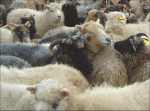 The nutritional
content of the seaweeds varies seasonally, in fact it shows even greater
seasonal variation than terrestrial herbage. Amazingly these sheep have
adapted their digestive systems to utilize the peculiar sugars present in,
particularly, brown seaweeds. These sugars are different from those present
in green plants. Brown seaweeds contain alginic acid, proteins, mannitod and
laminarin. The first mentioned has a structural function and the last is the
seaweed equivalent of starch. Laminarin is a glucan. Starch is a mixture of
amylose and amylopectin. It appears that in simple terms the Orkney sheep
rumen bacteria can break down the laminarin when very efficient rumen protosoa
utilise the glucose so formed, all since 1832. The nutritional
content of the seaweeds varies seasonally, in fact it shows even greater
seasonal variation than terrestrial herbage. Amazingly these sheep have
adapted their digestive systems to utilize the peculiar sugars present in,
particularly, brown seaweeds. These sugars are different from those present
in green plants. Brown seaweeds contain alginic acid, proteins, mannitod and
laminarin. The first mentioned has a structural function and the last is the
seaweed equivalent of starch. Laminarin is a glucan. Starch is a mixture of
amylose and amylopectin. It appears that in simple terms the Orkney sheep
rumen bacteria can break down the laminarin when very efficient rumen protosoa
utilise the glucose so formed, all since 1832.
The grazing habits also have
had to change with the diet. Instead of grazing during the day and ruminating
at night as other sheep generally do, the North Ronaldsays graze with the
tides (twice in 24 hours) and ruminate between low water periods.
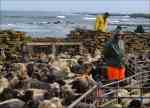 The native
flock on the island is controlled by a Sheep Court with Native Sheep
Regulations which state the number of sheep each croft can keep e.g. Holland
60, Bridesness 25, Newbiggins 45, Garso 25, Bewan 20. There are 18
regulations in the 1968 version which were substituted on 4th September 1968
for those of 1902. They cover sheep marks, the repair and up-keep of the dyke,
disposal of corpses, the election of Sheepmen - "elected by the districts
respectively to carry out and enforce the present Regulations, strictly,
honestly and without fear or favour" - down to the Registrar - "Eighteenth -
the Registrar for his services, shall be allowed to keep fifteen sheep without
being called upon to keep up any share of the dykes"! The native
flock on the island is controlled by a Sheep Court with Native Sheep
Regulations which state the number of sheep each croft can keep e.g. Holland
60, Bridesness 25, Newbiggins 45, Garso 25, Bewan 20. There are 18
regulations in the 1968 version which were substituted on 4th September 1968
for those of 1902. They cover sheep marks, the repair and up-keep of the dyke,
disposal of corpses, the election of Sheepmen - "elected by the districts
respectively to carry out and enforce the present Regulations, strictly,
honestly and without fear or favour" - down to the Registrar - "Eighteenth -
the Registrar for his services, shall be allowed to keep fifteen sheep without
being called upon to keep up any share of the dykes"!
The sheep marks had to be
recorded "on or before the first day of February next" in the Sheep book. The
marks are made in the lambs' ears and are a language of their own. Here are
some of the descriptions, the sheep being seen face on, marks on the left ear
given first:-
Bewan Thumb bit behind, three
rips (stooed)
Lochend Rip, stooed hemlin
before
Grind Shear, axe behind
Parkhouse Four bits, three
ripe
North Manse Piece off and bit
behind, three rips
And so on for 67 crofts in
1934, alas many fewer today. A fascinating record just the same, part of a
separate unique life woven around a separate unique breed.
I became involved with it
because of a problem arising when the native flock began to be dispersed away
from North Ronaldsay in case some disaster - e.g. Foot and Mouth Disease,
massive oil pollution - should wipe out the flock with the loss of a unique
gene bank.
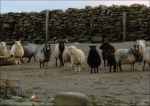 Groups of sheep
were moved to a variety of new locations many of them inland where the sheep
were faced with a diet consisting totally of terrestrial herbage. A
considerable number died unforseenly. The cause of death was Copper poisoning.
In a few cases this was the result of introducing mineral supplements to their
diet injudiciously containing Copper, but in the majority of cases there was
no apparent reason. I was called upon to investigate this and to do so a
small flock was set up at the V.I. Laboratory in Thurso and many visits were
made to North Ronaldsay. Briefly by analysing the mineral constituents of
terrestrial diets and the seaweed diet we showed the problem lay in the
Sulphur and Zinc levels, without going into too much technical detail, and
that after a number of our flock had died of classical copper poisoning while
eating only the grass and hay of the laboratory paddocks, we could arrest the
development of haemolytic crisis by administering zinc sulphate. We also
demonstrated that after two generations on terrestrial herbage the North
Ronaldsay sheep could re-adapt to terrestrial herbage and stopped dying
without zinc sulphate treatment. Groups of sheep
were moved to a variety of new locations many of them inland where the sheep
were faced with a diet consisting totally of terrestrial herbage. A
considerable number died unforseenly. The cause of death was Copper poisoning.
In a few cases this was the result of introducing mineral supplements to their
diet injudiciously containing Copper, but in the majority of cases there was
no apparent reason. I was called upon to investigate this and to do so a
small flock was set up at the V.I. Laboratory in Thurso and many visits were
made to North Ronaldsay. Briefly by analysing the mineral constituents of
terrestrial diets and the seaweed diet we showed the problem lay in the
Sulphur and Zinc levels, without going into too much technical detail, and
that after a number of our flock had died of classical copper poisoning while
eating only the grass and hay of the laboratory paddocks, we could arrest the
development of haemolytic crisis by administering zinc sulphate. We also
demonstrated that after two generations on terrestrial herbage the North
Ronaldsay sheep could re-adapt to terrestrial herbage and stopped dying
without zinc sulphate treatment.
Dispersed flocks on islands
like Linga Holm near Stronsay never had a copper poisoning problem because
their diet was terrestrial herbage plus seaweed.
This is but a glimpse of an
enchanting breed. Their story goes on with new horizons in the exotic breeds
market, the exotic wools trade and perchance the gourmet world.
It has been a rare and
delightful privilege to have been involved with them. Long may they continue.
Note
North Ronaldsay is the most northerly of the Orkney Islands that lie to
the north of Caithness across the Pentland Firth.
Map
See Also
More
On North Ronaldsay Sheep
First Published in Caithness Field Club Bulletin October 1988
Recent pictures from Jane and Peter of
A Yarn For North
Ronaldsay | 




